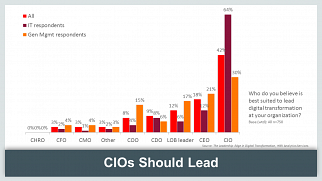tagged with: Harvard Business Review survey
Blog Post

I've saved the best for last in this series of posts on responsive IT. In our survey of 750 business and technology leaders (around 200 from IT and the remaining 550 from other parts of the business), 42% of respondents believe the CIO is the best suited member of the C-suite to lead digital transformation. (Yes, I know this term has become overused, but this is what we're talking about, so I'll learn to live with the shame.) That's more than twice as many as chose the CEO (18%). And that number shot up to 64% when we singled out the IT respondents. This is great news for CIOs, right?
Yes, but... when we look at the responses of general managers, things are less clearly defined. While CIOs still lead at 30%, there are also strong votes for the CEO (21%), LOB leader (17%), and COO (15%). This makes sense. As digital business becomes more pervasive, it is absolutely incumbent upon non-IT leaders to understand the opportunities and threats digital represents and to do everything in their power to drive their organization's ability to compete. Some of them are becoming quite astute in this regard. It's also true that even if the CIO is responsible on a day-to-day basis to lead this transformation, not much will happen without a clearly articulated vision from the CEO.
Blog Post

In a digital age, business survival depends on responsive IT. That is one of three key findings from a recent global survey of 750 business and technology leaders that I led for HBR Analytic Services ("The Leadership Edge in Digital Transformation"). Almost half of respondents (47%) said their organization had missed opportunities because IT was too slow to respond. While it's reasonable to expect some misses, companies with slow-to-respond IT departments were much more likely to say this at 64% than were respondents from companies with responsive IT (only 27% said they'd missed opportunities).
Companies with highly responsive IT (let's just call them the "Leaders" for brevity's sake) have gone faster and farther in making the transition to digital business than their competitors. This proved to be the case across many dimensions, starting with the ways in which they engage with customers: 68% of the Leaders said their customer engagement had been transformed by their use of new technologies compared with only 33% of Laggards. The delta was even greater when it came to business model transformation, with 62% of Leaders transformed compared with only 24% of Laggards. This translates directly to competitive advantage.
Blog Post
CIOs are facing a dilemma. On the one hand, they must innovate with technology to help their businesses grow again as we come out of the recession. On the other, because the recovery of 2010 will be slow and drawn out, they must continue to cut costs and focus on operational efficiency. In fact, 57% of executives surveyed by Accenture in November 2009 said that innovation and cost reduction are equally important to their company's ability to achieve future growth.




